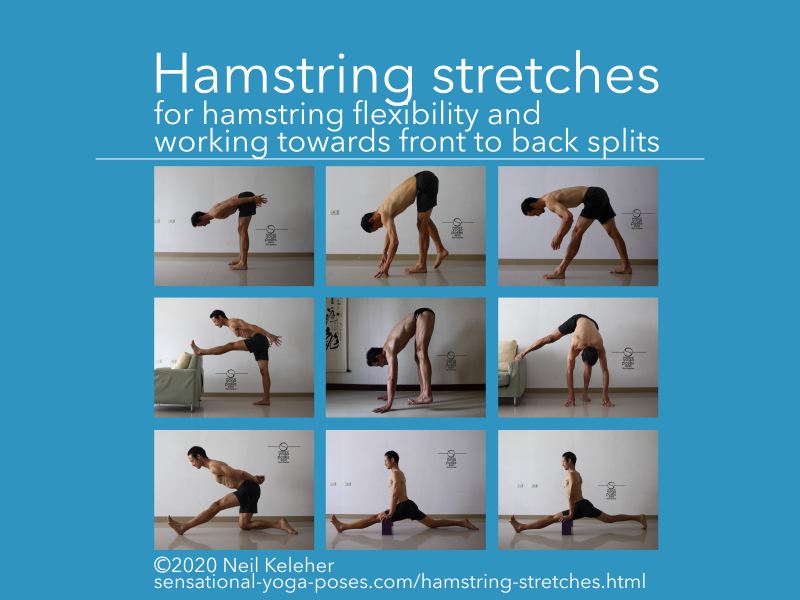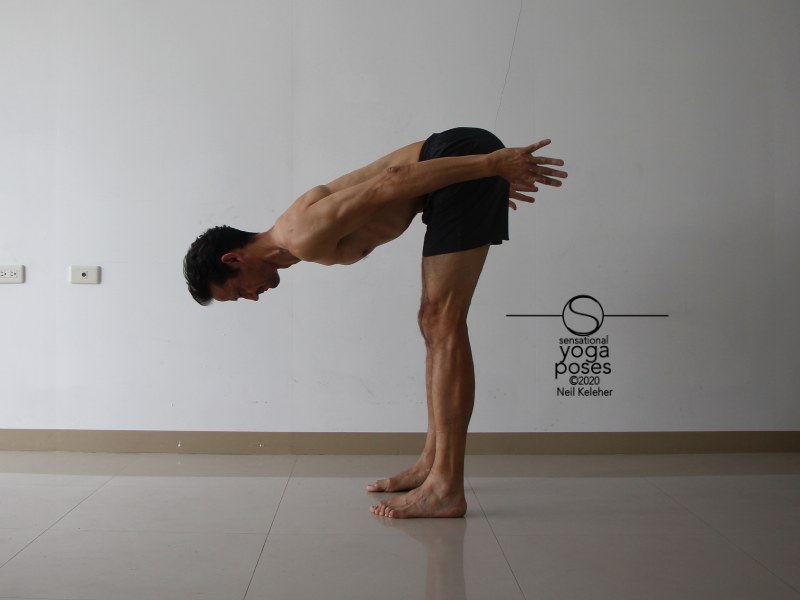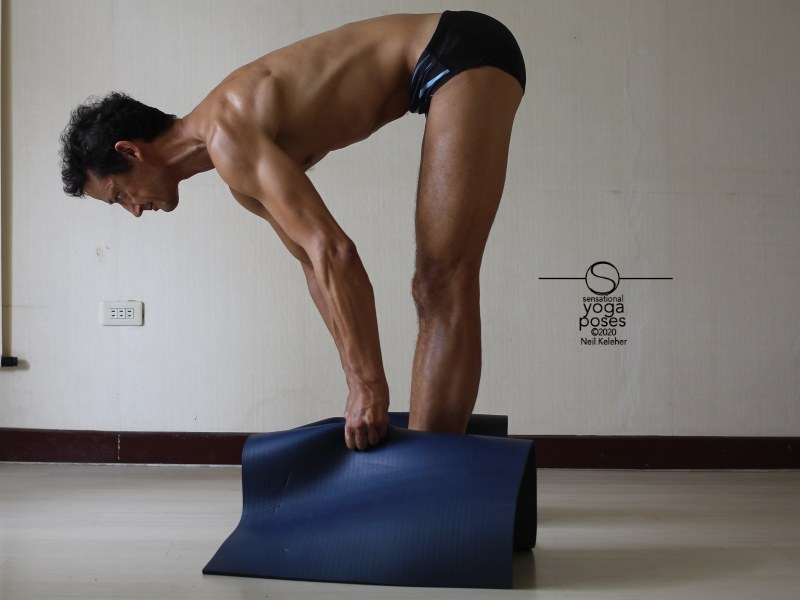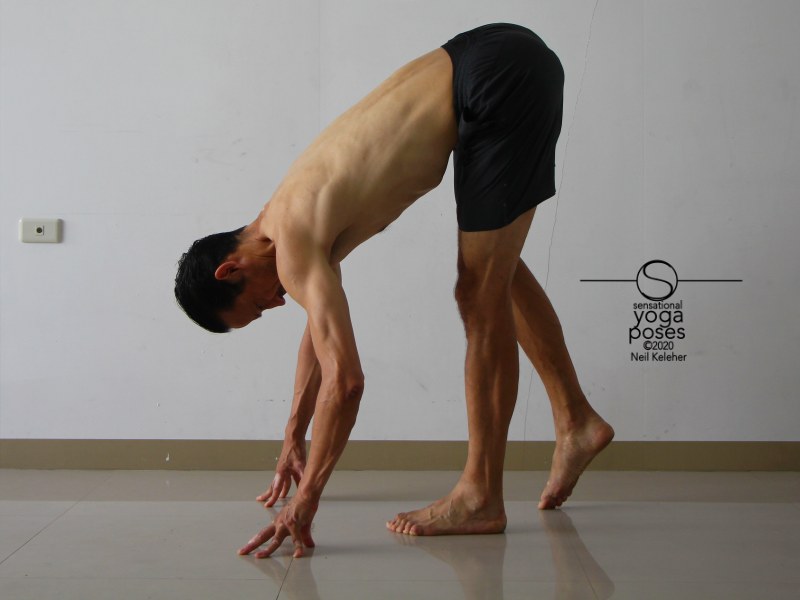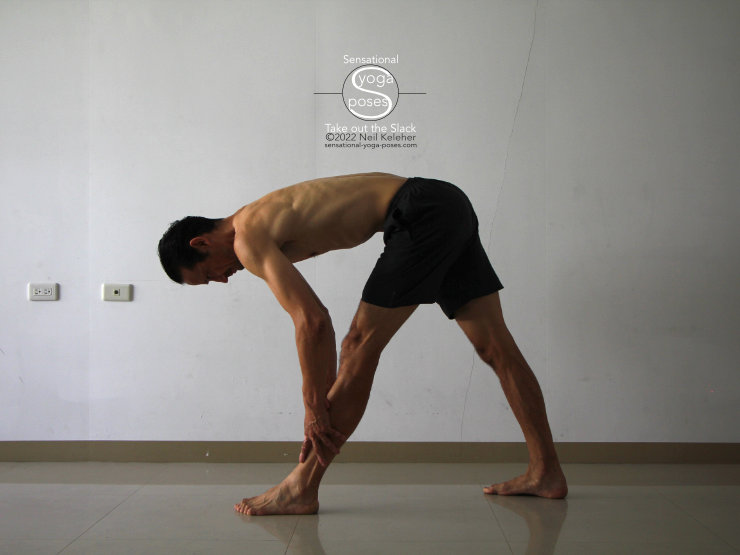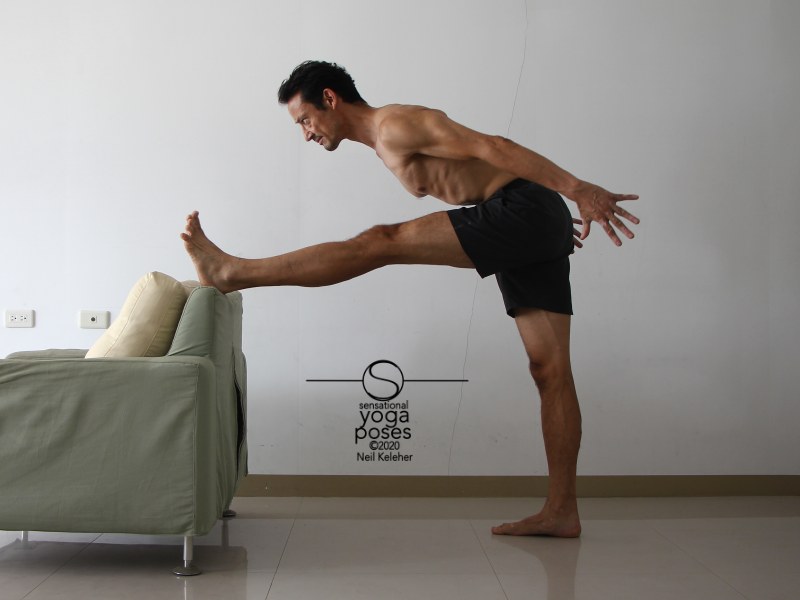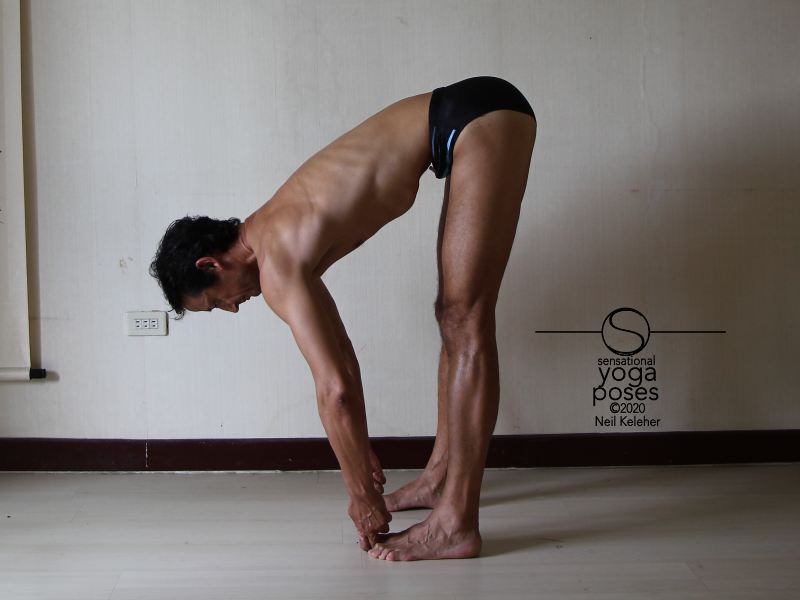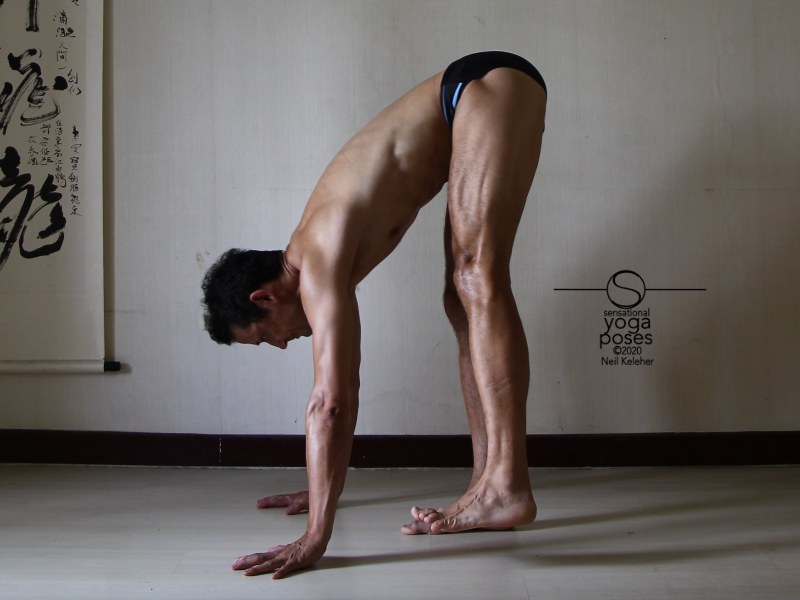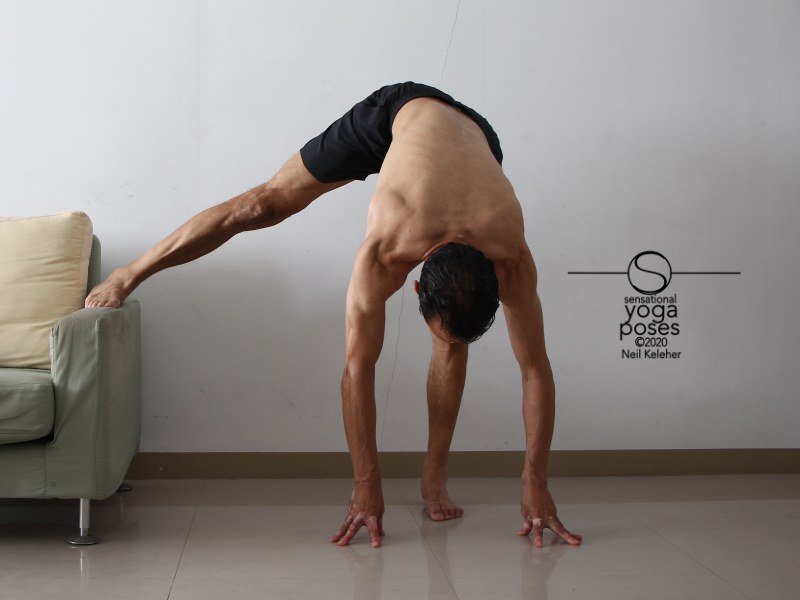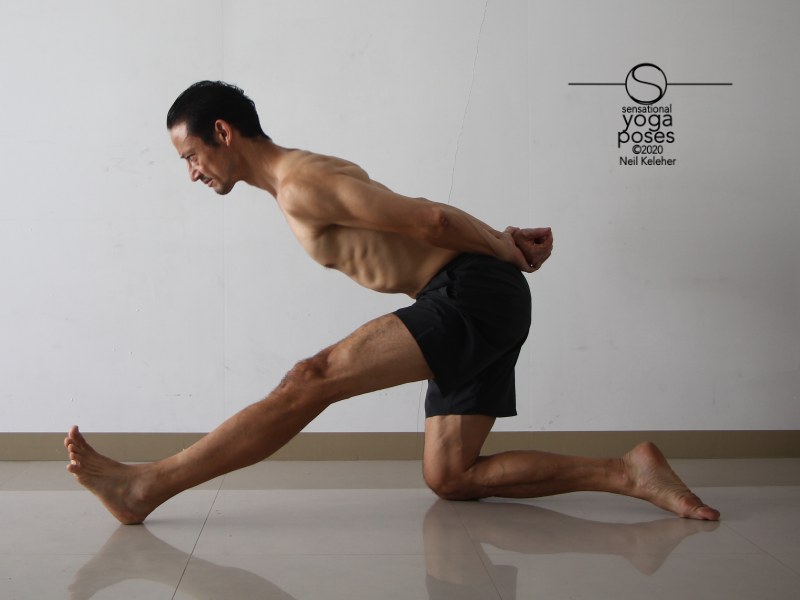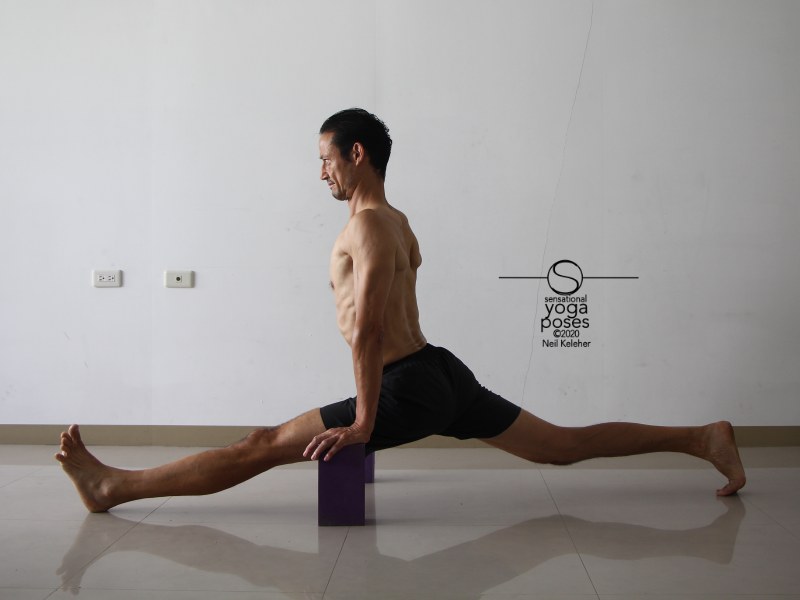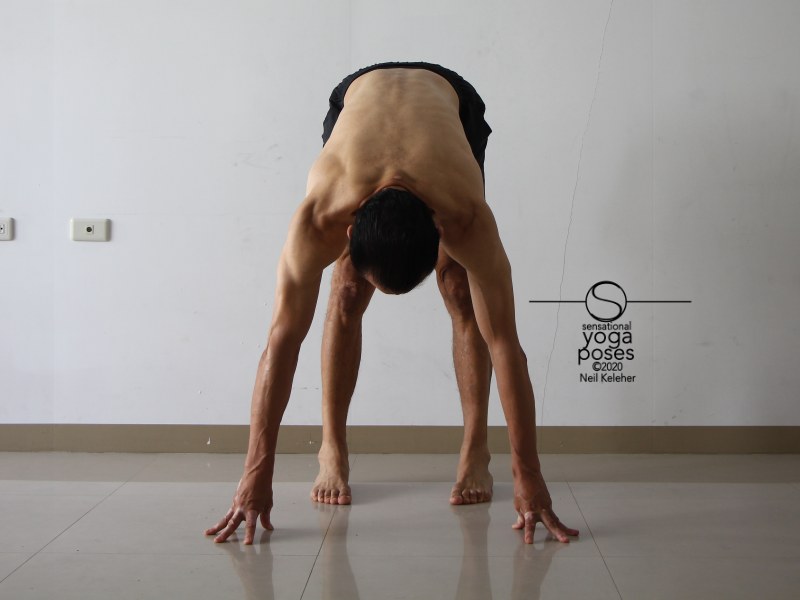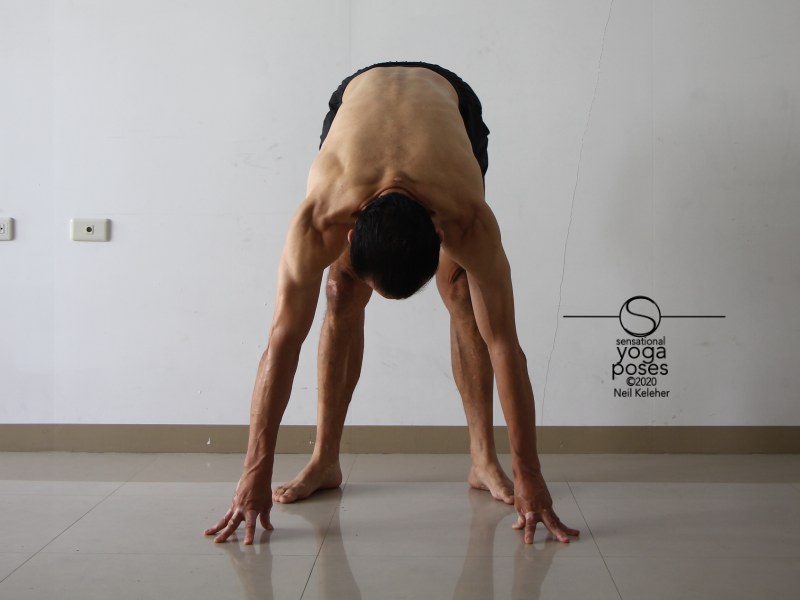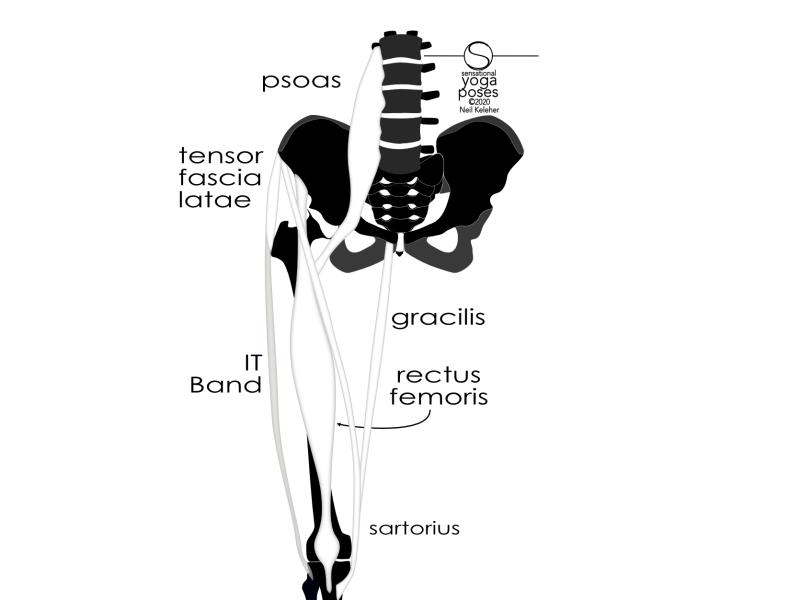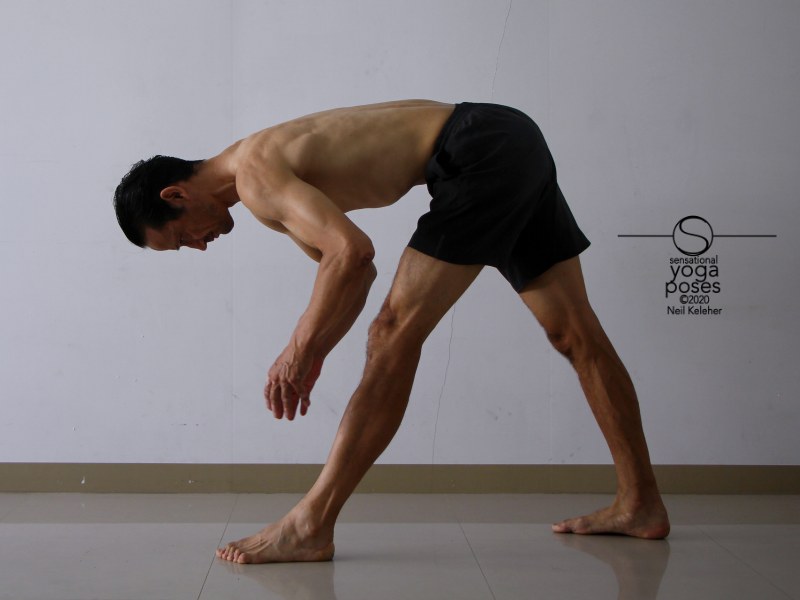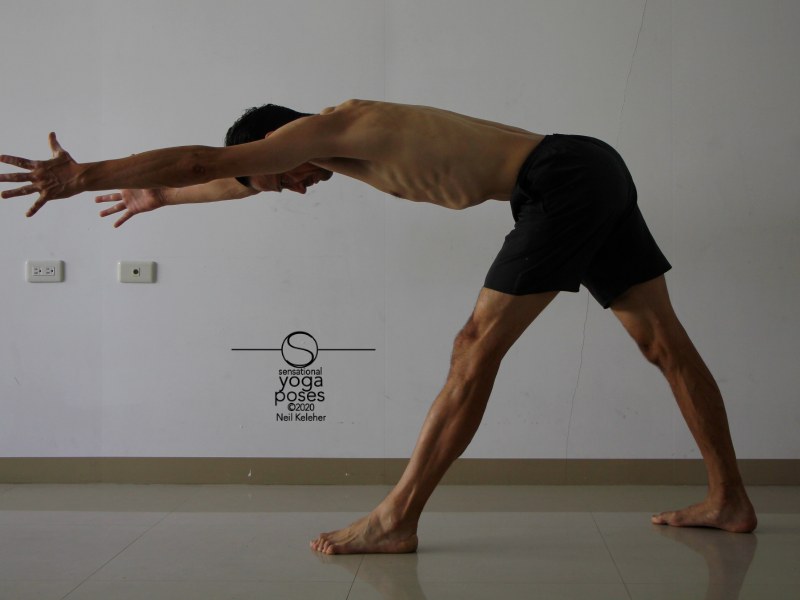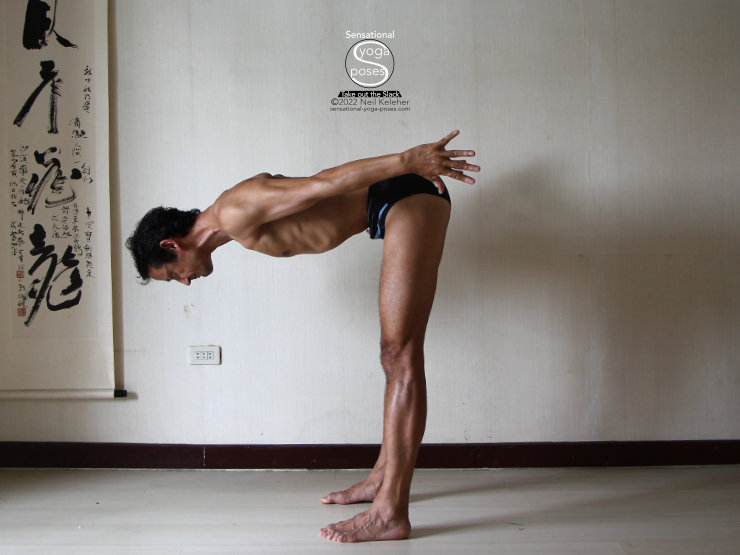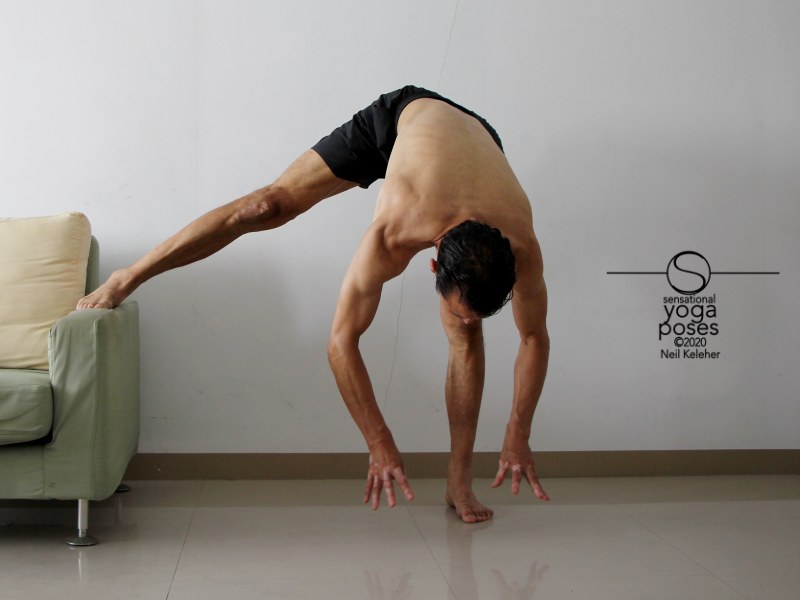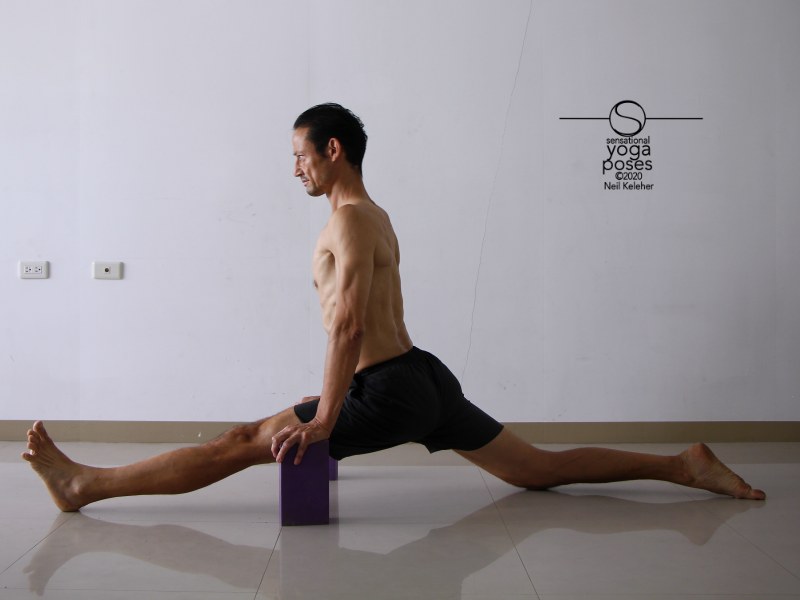Hamstring stretches
(and posterior glute stretch) for working towards front to back splits
These hamstring stretches can be used to stretch the hamstrings and as a preparation for the front leg when working towards front to back splits.
Stretching the hamstrings involves opening the back of the hip while keeping the knee straight. This can be done by tilting the pelvis forwards relative to the leg or moving the leg forwards relative to the pelvis.
In either case you can use the hamstrings to resist the stretch (and to lower yourself under control). You can also use your hips flexors (sartorius, tensor fascia latae and rectus femoris) to assist the stretch or make it an active hamstring stretch.
The hamstrings run down the back of the thigh and act on the back of the knee and the back of the hip joint.
When active, the hamstrings can be used to close the back of the hip joint by either tilting the pelvis backwards or moving the leg rearwards relative to the pelvis.
When acting on the knee, they can be used to bend the knee.
At the back of the knee the tendons of the hamstrings cross the tendons of the gastrocnemius, one of the main calf muscles.
When the knee is straight, these tendons press against each other. As a result, hamstring stretches can affect, and be affected by the calf muscles, in particular the gastrocnemius.
Discomfort felt during hamstring stretches may actually be occurring in the calf, versus the hamstrings (or as well as the hamstrings).
And so you may need to consider stretching your calves as well as your hamstrings.
Hamstring stretches could also be thought of as hip extensor stretches. However, they are hip extensor stretches done with the knee straight. So that hamstring stretching is easier you may find that on occasion it helps to do bent knee hip extensor stretches first.
Bent knee hip extensor stretches take the focus away from the dual joint hamstrings muscles and focuses stretching on single joint hip extensor muscles.
In the hamstring stretches on this page (and any other hamstring stretches you can come up with), there are a couple of basic techniques, (muscle control techniques) that you can use to make hamstring stretching more effective and to help improve hamstring flexibility.
One basic muscle control technique for stretching the hamstrings is to activate the hamstrings to resist the stretch. You can either activate the hamstrings, then relax them and sink deeper into the stretch while relaxing or you can activate the hamstrings and go deeper into the stretch while keeping the hamstrings active.
In either case you need to be able to control the hamstrings.
Another method that you can use to stretch your hamstrings is use your hip flexors to actively stretch your hamstrings. Where the hamstrings can act to open the front of the hip joints the hip flexors work to open the backs of the hip joints.
Note how all of these techniques involve some element of muscle control. You may find that the better you are at controlling your muscles (and that includes being able to feel when they are active or relaxed) the easier it is to improve the flexibility of muscles like your hamstrings.
To stretch your hamstrings in standing forward bend you can activate your hamstrings by creating a downwards pull on you sitting bones. You'll then be activating your hamstrings (and probably your posterior glutes or "gluteus maximus" muscle) against the weight of your body.
So that it is easier to activate your hamstrings you may find it helpful to stiffen your feet and ankles. Try to stiffen your feet in such a way that the tendons at the front and back of your ankles engage. Once you've stiffened your feet then try creating a downwards pull on your hamstrings so that you tilt your pelvis rearwards a slight amount. Your body should lift as you do this. Pause and then relax the downwards pull on your sitting bones. Allow your body to sink down. See if each repetition you can go a little bit deeper.
Note that to stand up, you can simply continue to pull down on your sitting bones until your body returns to upright.
If you find your hip joints are uncomfortable while standing up, or if at any point you find your hip joints uncomfortable, try adjusting the rotation of your feet, either inwards or outwards so that your hip joints feel comfortable.
If you find that standing with knees straight is too uncomfortable or your hips consistently creak while doing this, then you might want to stand up with knees bent. Or work at standing slowly and mindfully so that you can adjust foot rotation as you stand up.
Once you get used to activating your hamstrings to resist the stretch, what you can play with is keeping your hamstrings active both as you lift your torso and as you lower it. In either case work at moving slowly and smoothly. Think of the the phase where you lower your body as if you are using your hamstrings to slowly lower your body under control. They'll be stretched as you do this.
If you have difficulty activating your hamstrings, an alternative is to use a strap around your feet or stand on your yoga mat sideways and grab onto the edges of your mat.
Use your arms to pull up on the mat while keeping your torso still. You hamstrings and posterior glutes should activate against the force of your arms. You can resist, and then relax and sink deeper. Alternatively, try sinking deeper while keeping your hamstrings active.
Instead of using a strap and arm resistance to activate your hamstrings and glutes while doing a standing forward bend, you can try creating a downwards pull on your sitting bones.
Your sitting bones are the bony protrusions at the base of your hip bones that you can feel when sitting on the floor or on a reasonably firm chair.
While bent forwards, try creating a downwards pull on your sitting bones, as if pulling them towards the backs of your knees. Focus on feeling your glutes and hamstrings activate and use them to tilt your pelvis back and lift your body a slight amount.
Then relax and let your body bend forwards at your hips. See if after each repetition you can allow yourself to go a little bit deeper.
As an alternative to bending forwards while standing and stretching both legs, you could stand with your weight on one leg, with the other leg positioned with the foot lightly on the floor behind the standing leg.
Here you can focus on creating a downwards pull on the sitting bone of the standing leg to activate the hamstrings of that leg.
You can use the same options, pulling down on the sitting bone and then relaxing, or activating your hamstring as you lift your body and keep them active while lowering and bending forwards.
In both of the aforementioned standing forward bends you could also experiment with using your hip flexors to stretch your hamstrings. The hip flexors in question are the rectus femoris, sartorius and tensor fascia latae.
All of these hip flexors attach at or near the ASICs, the point at the front of your hip bone. To activate these muscles, stiffen your feet and ankles as before, and then work at creating a downwards pull on your ASICs.
If doing a standing forward bend with feet even, you could focus on activating the hip flexors one leg at a time.
In pyramid pose, you bend forwards with one leg in front of the other, both knees straight and both feet flat on the floor.
You can rest your hand on your front leg to begin with.
Focusing on activating your hamstrings, you could create a downwards pull on your front leg sitting bone, and then your back leg sitting bone, after first activating the feet and ankles. To make your hamstrings work a little harder you can lift your hands. From there, to make them work harder, and to give you a better feel for both them and your posterior glutes, you can slowly and smoothly reach your hands forwards.
As with standing forward bend, you can also experiment with using your hip flexors to stretch your hamstrings. You could choose to focus just on your front leg or just on your back leg. Or try activating your front leg hip flexors and then your back leg hip flexors so that both legs are active.
As before, I'd suggest activating your feet and ankles before hand.
For pyramid pose you can use the same basic technique, using a strap on your front foot. Another option is to not use a strap and instead activate your hamstrings and gluteus maximus (of the front leg) against the weight of your body.
Standing with one leg forwards and the other leg back, with both knees straight, bend forwards and rest your hands on your front shin. Make your spine feel long (You can lift your body as you do this) and lift your hands. Try to use the hamstrings and gluteus maximus of your front leg to support your body.
To add more weight and give your hamstrings more force to work against, slowly and smoothly reach your arms forwards. Then lower your hands to your shin and relax.
See if you can sink deeper, stretching your hamstrings, as you relax.
If you have a table, or counter (a step-ladder) or some other prop that is hip height or higher, you can stand with one leg elevated.
Staying upright, you can press your leg down against the support to activate the hamstrings and glute of that leg. Keep your body still as you press down.
Once you get used to this action, work at making your foot and ankle active prior to pressing down.
After a few repetitions, you can try to bend forwards at your hip as you relax, stretching the hamstrings of the lifted leg as you bend forwards. Pressing the leg down while bent forwards, again prevent your body from lifting as you press down. Then if possible, sink deeper as you relax.
Another option here is to try to bend forwards while your hamstrings are active.
You can do this same exercise with your torso turned to the side so that you are bending sideways at the hip to stretch your hamstrings.
For all of the hamstring stretches thus far, and the ones that follow, an additional activation you can do is making your spine feel long and also pulling your belly in via your transverse abdominis.
What you may find helpful is to activate your foot and ankle first. Then create a downwards pull on either your sitting bones or ASICs to activate your hamstrings or hip flexors. From there lengthen your spine. Then engage your transverse abdominis. Then from there either lift your body by pulling down on your sitting bones or lower it by pulling down on your ASICs.
In this standing hamstring stretch, the idea is to bend forwards with your weight centered over one leg. Lift the other foot and actively pull the lifted leg forwards. Work towards doing it with the lifted knee straight.
You can activate the foot and ankle and then create a downwards pull on your sitting bone. Once your hamstrings for the standing leg are active, then create a forwards pull on the lifted leg. You'll be using the hip flexors of that leg.
For an extra challenge, try lifting your hands off of the floor a slight amount.
Another version of the "table" stretch is to bend down towards the standing leg.
Turning your body to face in the same direction as your standing knee, you'll find that your lifted leg will rotate inwards. You can then position the foot so that it's instep is against the table top.
Note that when first trying this, have a prop like yoga blocks or a chair, or rest your hands on your standing leg as you bend forwards.
As you get more comfortable with this hamstrings stretching option, one suggestion is to work on going hands free. This can be quite challenging, hence the recommendation to have a chair handy if you have difficulty standing back up.
Use the muscles of your standing leg to control your hips and torso both as you bend forwards, and as you stand up.
Note, if you get hip discomfort while attempting this, then leave it out
For this hamstring stretch, you can kneel on one shin with your hips lifted and your other leg straight.
Position your hips over your bent knee so that the thigh of that leg is vertical. Viewed from the front, position your straight leg foot so that it is about hip width side-to-side with respect to the knee of the bent leg.
Similiar to the table stretch, you can press your heel down against the floor to activate your hamstrings in this position. Try activating your foot and ankle first, then press your foot down and feel your hamstrings activate. You can then work at incrementally bending forwards either while relaxing, or while keeping your leg active.
Additionally, while activating your leg, you can lengthen your spine and pull in your belly to activate your transverse abdominis.
You can use this same basic technique in any seated hamstring stretch whether on knee is straight or both are straight. Activate foot and ankle, then push the heel of the leg you are stretching into the floor to activate your hamstrings.
Another option is to create a pull on your ASICs towards your knee to activate your hip flexors. Keep your knee active and straight while attempting this. It may feel like you are trying to lift your leg off of the floor.
If you've already warmed up your hip flexors, you can start sliding your front foot forwards from the semi-kneeling hamstring stretch and work on front to back splits.
While in the splits you can deepen the hamstring stretch by bending forwards, I'll suggest here that you can still get a hamstring stretch with your torso upright.
To that end you may find it helpful to use a pair of yoga blocks so that you can support the weight of your body using your arms.
Note in the first picture the top of my back foot is flat on the floor. In the second the toes are tucked and my knee is lifted.
To make it easier to stretch your back leg hip flexors, you may find it easier to tuck the toes of the back foot and press down through the ball of your foot. prevent your hips from lifting while doing this. Press down slowly and be aware of your back knee while doing this. You can work at straightening your back knee as you press down.
For the front leg you can activate the front foot and ankle and then press down through the heel to activate the hamstrings. Work at keeping both legs active and see if you can sink your hips down while doing so.
Another option is to activate the hamstrings of the back leg and the hip flexors of the front leg (one at a time or together) as if trying to lift your legs off of the floor.
For either option (pressing the feet down or creating an upwards pull) you may find it helpful to make your spine feel long and to pull in your lower belly using your transverse abdominis.
Published: 2020 07 03
Updated: 2023 03 27
